by Editor | Oct 19, 2015 | Attractions, Luxury Travel

A scene from Hansel and Gretel (photo credit: Opéra National de Paris/Julien Benhamou)

The historic Palais Garnier is a work of art
We found a fun alternative to the many tried and true though often crowded monuments and museums of the City of Lights at the two Paris Opera theaters. The best known of the two theaters was the Palais Garnier on the Place de l’Opera. Limited performances and a relatively small building meant finding seats required advance planning. Once inside the ornate interior was worth the effort.
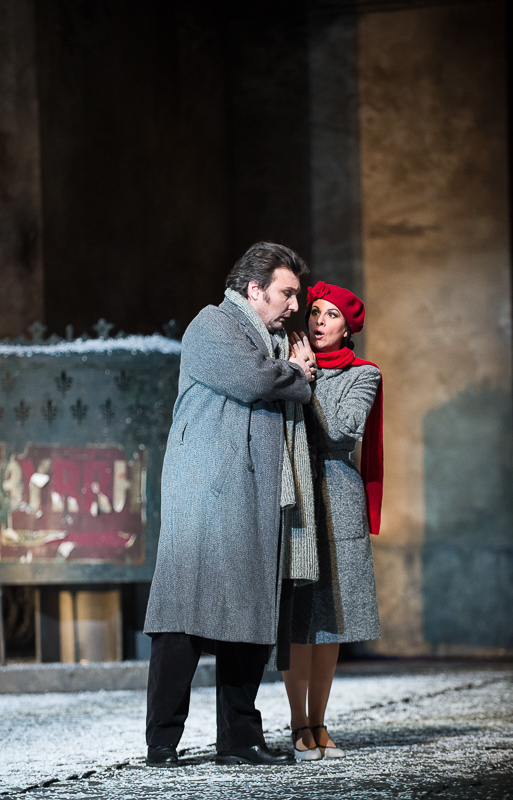
Scene from La Boheme (photo credit: Opéra National de Paris/Julien Benhamou)

The Opera Bastille is in a major traffic circle on the Right Bank
In the eastern side of the city near the famed Marais neighborhood, the Opera Bastille offered a large venue. The ample seating choices available meant the freedom to go to the opera on impulse. From a tourist perspective the Palais Garnier was our favorite. From a musical performance perspective we preferred the Opera Bastille.
by Editor | Sep 28, 2015 | Attractions, New Articles
Photos by Aaron Lubarksy

An advertisement for the Whitney on the stairs of the New York City subway
Earlier this year, the Whitney Museum of American Art opened its new location in the Manhattan Meatpacking District. Our contributors visited the museum and liked the building, which they considered a work of art in itself, and its contemporary art collection.

A sculpture on one of the Whitney’s terraces
They saw famous paintings by contemporary artists Edward Hopper, Willem De Kooning, Barbara Kruger, and Jean-Michel Basquiat. They also appreciated the surrounding neighborhood full of markets, restaurants and views, and took advantage of their visit to explore the area near the building.
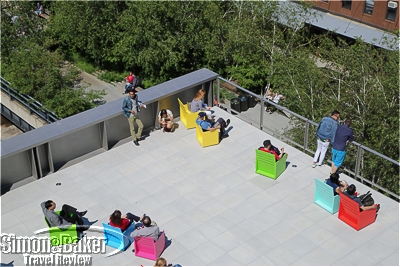
A site-specific exhibit by Mary Heilmann on the largest outdoor gallery at the museum
by Editor | Sep 8, 2015 | Attractions, Luxury Travel
Article and photos by Elena del Valle

Signs along the trail described its history
During a recent stay in Bloomington, Indiana I discovered the B-Line Trail, a 12 food wide asphalt, multi-use 3.1 mile pedestrian and cyclist pathway, when I asked about jogging near my centrally located hotel. Meetings and activities kept me busy the majority of the days and into the early evenings. Taking advantage of the little free time I had at my disposal in the early mornings I set out to explore as much of the trail as I could.

One of five different exercise devices in three fitness stations on the trail, south of First street
It ran from the east side of Adams Street, through downtown, past the switchyard property, to the north side of Country Club Drive. It had well marked ground level street crossings at the intersections. Many of the cars stopped or slowed down when they saw pedestrians at the crosswalks. There were pedestrian bridges over Third Street and Grimes Lane. There were paved plaza areas next to City Hall, at the WonderLab Museum, behind the Convention Center, and at Seminary Square shopping center. There were exercise stations, benches and public art scattered along the trail, especially near the downtown section.

There were signs highlighting spots along the trail
Perhaps because of the summer break it was a bit lonely jogging in the predawn hours. Some of the graffiti peppered under bridges and abandoned buildings spooked me at first. As the sun rose, there were more people cycling, walking, jogging and walking their dogs. Some took advantage of the two foot wide gravel shoulders on each side.

A view down the trail in the early morning from one of the bridges
Every so often there were garbage bins, bags for dog poop, and new looking LED street lamps on the trail. Even in the area furthest from downtown Bloomington it was never dark for very far on the path. Along the green sections, bird song mixed with the background buzz of early morning traffic and the mechanical sounds of nearby construction. Every once in a while I spotted birds. One mornings, I saw a rabbit next to the trail.

One of many signs that marked the trail path
Signs described the project, which was accomplished by the city through land acquisition for the three-mile former rail corridor (most of the costs, 80 percent, were funded by federal grant dollars). Other signs highlighted historical landmarks and public art. There were eight art pieces on the trail. I noticed a weathered steel sculpture titled “Dancing Spirit” near downtown. Some of the buildings I passed had murals made possible by a city grant.
The city had bought 28 acres of land adjacent to the southernmost section of 1.25 miles from Grimes to Countryclub in the abandoned former McDoel Railroad Switchyard. Administrators planned an addition to be named Switchyard Park and meant to feature outdoor performing arts venues, active recreational sport courts, walking trails, skatepark, splash pad, playground, and large multi-use facility.
Every morning I looked forward to my walks and jogs on the trail. They allowed me to exercise and discover a little of the city and its history, including some brush and greenery. On the path, I came across a convenient grocery store and a small cafe where I bought nutritious and tasty smoothies. The next time I visit Bloomington, I will seek accommodations near the B-line Trail. Perhaps by then the Swityard Park project will be complete.

by Editor | Aug 24, 2015 | Attractions
Article and photos by Elena del Valle

One of two signs at the entrance to the Kumbum Chantse Ling Monastery in Bloomington, Indiana
My favorite attraction during a three-day visit to Bloomington, Indiana was the Tibetan Mongolian Buddhist Cultural Center (TMBCC). As soon as we arrived at the brightly painted Tibetan style entrance gate I was transported back to Asia. A scant five miles from the city center the 108-acre property housed Chamtse Ling Temple, Cultural Building, two traditional Tibetan stupas, four retreat cottages, a Teaching Pavilion and two private residences. In the Cultural Building, where I and my tour group spent most of our time, there was a library, a kitchen, community space and an amply stocked gift shop.

The stupa at the Tibetan Mongolian Buddhist Cultural Center
Founded in 1979, the Center’s three main goals were to foster and preserve Tibetan and Mongolian cultures, provide Buddhist teachings to the community, and promote interfaith peace and harmony. As a monastery it had a permanent small monk population that lived onsite year round. The center and temple were open to the public.

A meeting room at the Tibetan Mongolian Buddhist Cultural Center
We began by visiting the Cultural Building’s Main Hall, where we had lunch in an informal area adjoining the kitchen. Following the simple self serve meal of delicious noodle soup, corn on the cob, and lettuce with a memorable dressing (although there was hardly any lettuce by the time I had a chance to serve myself, the dressing was my favorite part), we moved to an adjacent meeting room.

We had self serve noodle soup, corn on the cob, and lettuce salad for lunch
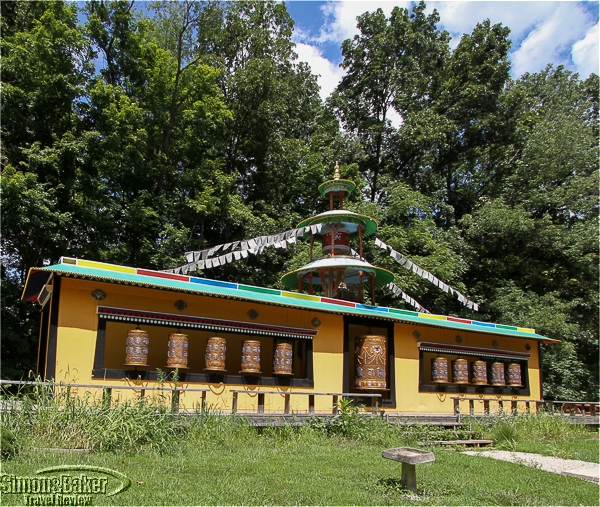
Wheels at the Tibetan Mongolian Buddhist Cultural Center

Tibetan monks from the Labrang Tashi Kyil and Tibetan Mongolian Buddhist Cultural Center, a refugee monastery in Dehra Dun, India
Seven Tibetan monks from the Labrang Tashi Kyil and Tibetan Mongolian Buddhist Cultural Center, a refugee monastery in Dehra Dun, India, were visiting the Center. One by one they recited their life stories. Most of them spoke in their native tongue while one of their colleagues translated in thickly accented English. A Center volunteer explained they were touring the United States to share a message of wisdom, and searching donations for their monastery, where 50 young monks from the Tibetan-Himalayan region were awaiting education and receiving healthcare.
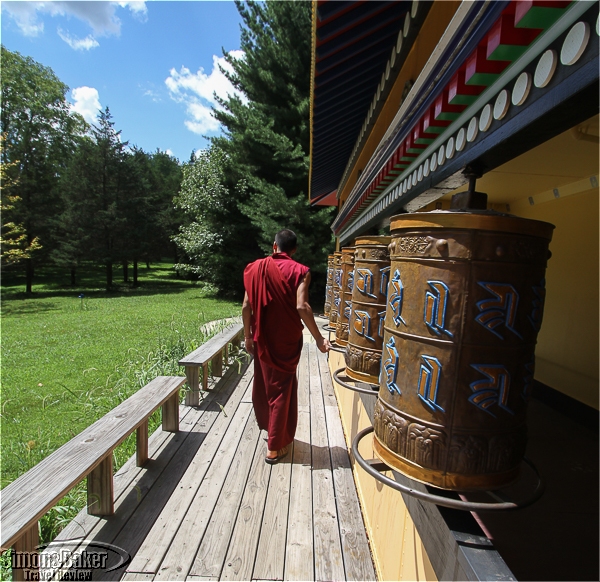
A monk walked by the wheels at the Tibetan Mongolian Buddhist Cultural Center

Tibetan style sand artwork in the Dalai Lama’s private quarters
From there we walked a short distance over a narrow paved path and green grass to the wheels and stupa en route to the Kumbum Chamtse Ling Monastery set aside for classes, meditation instruction and retreats. The upper floor, closed to the public, was home to the private quarters of the Dalai Lama, the religious leader of Tibetans.
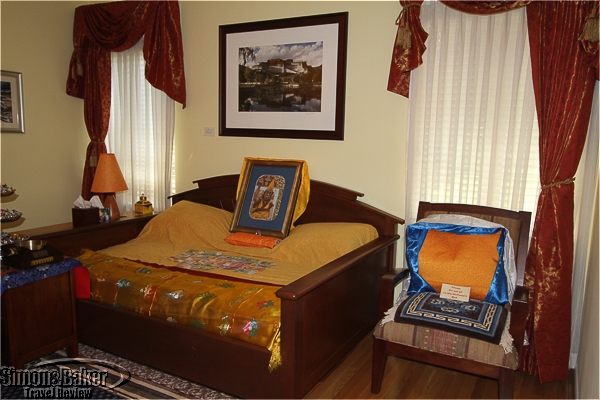
The Dalai Lama’s bedroom
The 501 (C) 3 nonprofit organization’s main sources of funding were programs, facility rentals, donations and guest lodging. I would recommend a stop at the Tibetan Mongolian Buddhist Cultural Center (3655 Snoddy Road, Bloomington, Indiana, 47408, United States, +1 812 336 6807, TMBCC.org, tmbcc.kc@gmail.com) to friends wishing to visit a Tibetan Buddhist temple in the United States. I enjoyed lunch, and the three-hour afternoon group tour, and would welcome the opportunity of a return independent visit with quiet time to further explore the center and its grounds.
by Editor | Feb 2, 2015 | Attractions
By Elena del Valle
Photos by Gary Cox

Exterior view of the studio (click to enlarge)
American painter Winslow Homer (1836-1910) lived and worked on many of his masterpieces from 1883 until his death in Prouts Neck, Maine where he enjoyed dramatic views of the ocean crashing against the rocky coast, which inspired his famous artwork, and some believe transformed marine painting in American art. Last fall, while staying at the Inn by the Sea in nearby Cape Elizabeth, Maine, we had an opportunity to stop by the Winslow Homer Studio (http://www.portlandmuseum.org/homer/visit, +1 207 775-6148), his former home and studio in Prouts Neck, about 12 miles from Portland, now restored and part of the Portland Museum of Art in Portland.

Worktable with a view located in the studio (click to enlarge)
The building was moved 100 feet away from the “Ark,” the house next door, and converted from a carriage house to living quarters in 1883 by John Calvin Stevens, an architect, and his brother-in-law Howard Stevens, of the Portland firm Fassett and Stevens. In 1890, Homer had the porch, pergola and a painting room added. Today, the Studio is 2,200 square feet, 44 feet by 53 feet, and two stories high.

The fireplace with a few original touches
Few original items remained at the time of our visit. They were: a bench called an Inglenook, a detail common in architect John Calvin Steven’s homes; his fire bucket (with initials W.H.); moose antlers over the mantle; the sign he made “Snakes, Snakes, and Mice” that he put outside, as he said, “to keep away the rusticators;” his pipe and tobacco, his copper kettle, and his chair. The wooden mantle and the fireplace were painstakingly restored to their original state.

The daybed and wall mounted trophies (click to enlarge)
By the main living room north interior wall, there were items belonging to Winslow Homer: daybed, fish trophies, fishing pool, eel spear, and sawfish bill. The museum added reproductions of photographs of the artist and his family and a facsimile of a family album to illustrate the story of Homer’s everyday life at Prouts Neck. Museum staff believed that in the painting room west window and south interior wall a Chinese table, and props from paintings hint at the lush interior of Homer’s New York apartment, and provided a contrast to the rustic nature of his life at Prouts Neck. Items from his Studio, a bell and an octant, as well as a medal Homer received from the Carnegie Institute, decorated the tabletop dating to 1896.

Weatherbeaten from the Portland Museuam of Art (click to enlarge)

The coast, a short distance from the studio, was the inspiration for Weatherbeaten (click to enlarge)
Inspired by the rugged beauty and dramatic weather of Prouts Neck Homer produced works that revolutionized marine painting in American art and created an iconic and enduring image of the New England coast. The Portland Museum of Art’s painting Weatherbeaten from 1894 served as the namesake for the exhibition and a quintessential example of the artist’s late work. Museum staff believed the image of rough waves crashing against a rocky shore embodied Homer’s ability “to capture the specificity of a place, while simultaneously meditating upon the timeless forces of nature.”

One of the display areas had information about the area.
According to a museum representative, in the artist’s Prouts Neck pictures, he envisioned nature as an arena for the constant clash of forces, water against rock, and humankind against the elements. In Eight Bells, 1886 painting displayed at the Addison Gallery of American Art, Phillips Academy, for example, he represented fishermen facing stormy weather at sea with Homer’s characteristic narrative ambiguity that experts believe leaves the viewer wondering about their fate. Homer’s iconic painting Fox Hunt from 1893, which rarely leaves the Pennsylvania Academy of Fine Arts, was expected to make its first visit to Maine since its creation. Experts who consider it a masterwork say it “thematizes mortality and evolutionary conceptions about the survival of the fittest that arose in the late 19th century.”

A reproduction of a photograph of Winslow Homer at the Studio
In 1893, Homer first exhibited at the Portland Museum of Art. In 1976, Charles Shipman Payson pledged his collection of 17 paintings and watercolors by Homer and an endowment that led to the construction of the Charles Shipman Payson building, the public face of the Museum. The Museum’s Homer collection also included such notable objects as his first important oil painting, Sharpshooter from 1863; an original watercolor paint box; and a significant collection of 400 wood engravings that represented 90 percent of Homer’s graphic output, and chronicled the artist’s early career as a commercial illustrator.

A view from the upper floor (click to enlarge)
Following the purchase and restoration of the building, a National Historic Landmark, in 2006, the museum opened the Studio to the public in 2012. In 2014, the museum, the Prouts Neck Association and the Scarborough Land Trust bought the land, a little more than half an acre, surrounding the Studio with the goal of conserving it in perpetuity as open, undeveloped space. The museum showcased three centuries of fine and decorative arts from the 18th century to the present, including renown artists such as Winslow Homer. Winslow Homer Studio tours, two and a half hours long, were available for up to 10 visitors at a time by reservation only. The tours departed from the Portland Museum of Art in a Mercedes Sprinter van.
by Editor | Jan 19, 2015 | Attractions, New Articles
Article and photos by Elena del Valle

Our view of the Nevis shore as we sailed toward Saint Kitts
During a recent stay in Nevis, part of Saint Kitts and Nevis in the Caribbean, I went on a relaxing three-hour morning sailing activity aboard the Caona, a pretty catamaran owned and operated by Leeward Islands Charters (Fort Street, P.O. Box 586, Basseterre, Saint Kitts, +869-465-7474, fax 869-465-7070, www.leewardislandscharters.com, sail@leewardislandscharters.com). The weather had been mixed due to regional storms and I wondered if the outing would be cancelled. Luckily, on the day of the activity, the weather was good and there was a slight breeze.

From the sailboat we saw Mount Nevis and the shoreline – click to enlarge.
From the Montpelier Hotel and Beach, a pretty and secluded hillside hotel on the other side of the island where I was staying, I made my way to the Four Seasons Hotel in time for our 11 a.m. departure. Crossing from the parking lot to the dock I was pleased when I sighted the Caona. The sailboat, made in Saint Kitts in 1985, was 47 feet long by 22 feet wide and had a maximum capacity of 24 passengers on the Nevis Sail & Snorkel activity. A friendly man with an island accent and a clipboard welcomed me, asking right away if I was staying at the Four Seasons Hotel where the boat had docked and everyone else was staying. I assumed he wanted to know what room to charge.

A beautiful day for sailing
I shared the boat with three couples, all Four Seasons guests visiting from the United States. Once we boarded the vessel, Lennox Wallace, our friendly captain, introduced himself and Elvis Richardson, his first mate; told us about the boat and its amenities, and what we would be doing.
At first we all sat in the shade next to the captain, getting to know each other and gazing curiously at the receding Nevis shore as we made our way slowly toward Saint Kitts. The sun felt warm and pleasant on my skin. Puffy white clouds peppered the cerulean Caribbean sky in a picture perfect moment. A mild breeze and the sound of splashing as we glided gently over the water completed the scene. The boat swayed with the gentle surf as we cut a line across the Caribbean waters in a westerly direction.

Lennox Wallace, our captain, at the helm
After spraying liberal quantities of sunblock, the captain had warned us to sunblock was essential, I carefully made my way forward. I sat down on the deck, bringing one of the many towels available with me in case the surface was hot (it was cool to the touch). Soon the couples also all made their way to the same area of the boat. Elvis brought us cold drinks. The choices were rum punch, beer, soft drinks and water. We chatted amongst us, exchanging pleasantries until the rhythmic lull of the boat soothed us into a companionable silence.

We snorkeled in clean turquoise water in Shitten Bay, Saint Kitts – click to enlarge
Before long we reached Shitten Bay, a calm cove in Saint Kitts where the crew anchored with ease. Although there had been a boat when we arrived, it departed within moments, leaving us in the privacy of our temporary shelter. We sighted a turtle before we had even settled in our new spot. While Elvis sorted out snorkeling gear for each of us the captain instructed us on the snorkeling site and safety procedures. Like the boat itself the snorkeling equipment was clean and smell free. I was delighted to discover they had fins and a mask that fit me.

Our catamaran was 47 feet long and 22 feet wide and could accommodate up to 24 passengers.
Within minutes of arriving we were all scattered in the warm water admiring the sea life below the surface.
Colorful tropical fish swam up to twenty feet below in a bed of rocks peppered with a few young coral. Slowly we each came back, climbed the ladder and dried off the salt water. After we all returned to the boat and settled down we headed back to our island. A short sail later we arrived back in Nevis, smiling. At the dock we all said our good-byes and headed back to our respective plans for the day. I sighed contentedly. The morning of pleasant sailing shared with a handful of equally pleasant people, and snorkeling in turquoise warm waters had left me with an irie feeling. That carefree sense was why I had gone to Nevis.












































